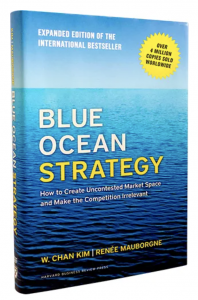Nearly 71% of the earth is made of water. That’s significant, especially when you realize that more than 80% of the ocean remains unexplored.
Even with modern technology, there is so much we have not experienced. Just imagine what wonders we have yet to find under the surface! The possibilities are many – and a similar idea applies when it comes to actualizing the growth of your business.
You’ve no doubt undertaken the effort to extend your brand’s reach, acquire new customers, and gain market share in different areas. Although those business growth tactics are standard, you may not realize they are essentially a part of – aptly – a blue ocean strategy.
 A Blue What?
A Blue What?
The theory behind blue ocean strategies stems from a 2004 book by W. Chan Kim and Renee Mauborgne. The authors examined hundreds of strategic moves businesses in different industries made over a 100-year period to determine why some found success breaking into new markets and others did not.
The results of their study culminated in a concept based on the metaphor of red and blue oceans that make up the current market. Red represents all the existing businesses and industries, while blue signifies underutilized markets or ones that don’t yet exist. Just like exploring the (real) earth’s watery depths, the blue side of this theory can show there is a lot more out there just waiting to be discovered.
The idea of blue ocean strategies involves using audience segmentation to tap into new market areas to acquire new business with little or no existing competition. This can be done in various ways, but the crucial – if ambiguous – point is not to find your blue ocean, but to make one.
By focusing on just a specific portion of your values or benefits, you can find an aspect of your business that aligns with an audience who is only interested in that same thing – and there’s your ocean.
Here are some guidelines to help you develop a framework for your own blue ocean strategy.
Find That Specific Value
The crucial part of this concept is to discern a value. Specifically, deciding which segment of your audience might only find value in a certain part of what you offer. For example, someone may not completely like Chevrolet SUVs, but they love the General Motors warranty and may invest because they value the protection plan more than the vehicle itself.
This idea identifies a segment of your audience that values a secondary or tertiary element of your business, who then become the fish in your new blue ocean.
Fish Where the Fish Aren’t
In marketing and advertising, a historical rule of thumb is to fish where the fish are. In other words, get your product/service and messaging to the people who are most likely to buy. But in a blue ocean strategy, you already know that, so the goal is to fish where the fish are not – yet.
 Once you have your audience segment pinpointed, you can alter your product or service to cater to their direct needs and interests.
Once you have your audience segment pinpointed, you can alter your product or service to cater to their direct needs and interests.
Initially, this may seem to deemphasize the other parts of your offering to this group, but it allows you to highlight what they find the most value in and then reposition everything else as value-added. In effect, identifying the portion of your audience that is keen on a certain aspect of your business is like stocking your own pond to fish in. You know their behaviors, their interests, and how to provide what they want.
This idea also creates a little latitude allowing you to focus the other parts of your offering to different segments in other markets. Thus, you end up with a new ocean you never knew was there.
With these concepts in mind, you’ll be able to find your own blue ocean strategy for your business and gain additional market shares. And if you’re unsure about how to find a unique value to appeal to a specific audience segment, we’re happy to help!
